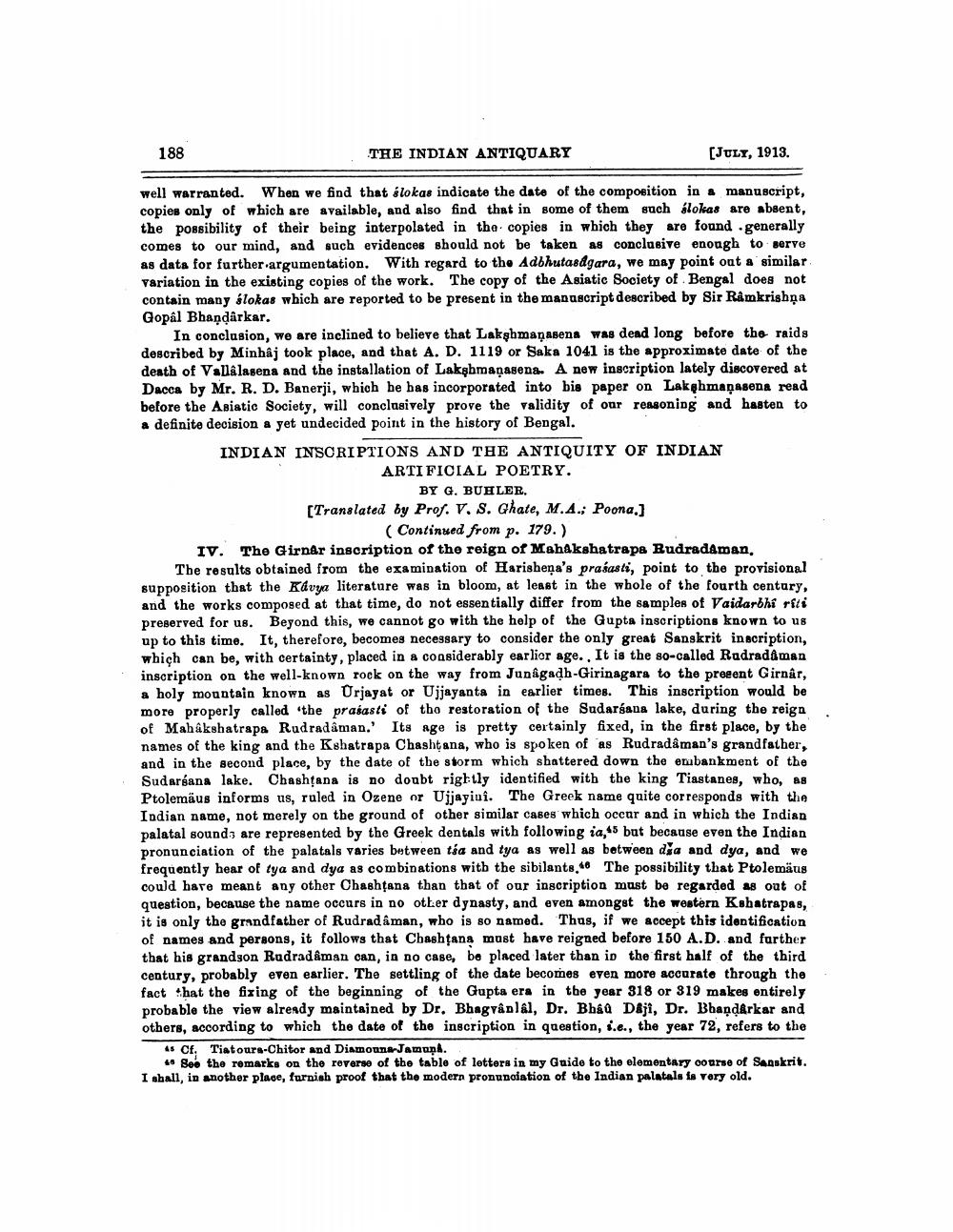________________
188
THE INDIAN ANTIQUARY
well warranted. When we find that slokas indicate the date of the composition in a manuscript, copies only of which are available, and also find that in some of them such slokas are absent, the possibility of their being interpolated in the copies in which they are found .generally comes to our mind, and such evidences should not be taken as conclusive enough to serve as data for further argumentation. With regard to the Adbhutasagara, we may point out a similar variation in the existing copies of the work. The copy of the Asiatic Society of Bengal does not contain many slokas which are reported to be present in the manuscript described by Sir Ramkrishna Gopal Bhandarkar.
[JULY, 1913.
In conclusion, we are inclined to believe that Lakshmanasena was dead long before the raids described by Minhâj took place, and that A. D. 1119 or Saka 1041 is the approximate date of the death of Vallâlasena and the installation of Lakshmanasena. A new inscription lately discovered at Dacca by Mr. R. D. Banerji, which he has incorporated into his paper on Lakshmanasena read before the Asiatic Society, will conclusively prove the validity of our reasoning and hasten to a definite decision a yet undecided point in the history of Bengal.
INDIAN INSCRIPTIONS AND THE ANTIQUITY OF INDIAN
ARTIFICIAL POETRY.
BY G. BUHLER.
[Translated by Prof. V. S. Ghate, M.A.; Poona.]
(Continued from p. 179.)
IV. The Girnår inscription of the reign of Mahakshatrapa Rudradaman, The results obtained from the examination of Harishena's prasasti, point to the provisional supposition that the Kavya literature was in bloom, at least in the whole of the fourth century, and the works composed at that time, do not essentially differ from the samples of Vaidarbhi riti preserved for us. Beyond this, we cannot go with the help of the Gupta inscriptions known to us up to this time. It, therefore, becomes necessary to consider the only great Sanskrit inscription, which can be, with certainty, placed in a considerably earlier age., It is the so-called Rudradaman inscription on the well-known rock on the way from Junagadh-Girinagara to the present Girnâr, a holy mountain known as Urjayat or Ujjayanta in earlier times. This inscription would be more properly called the prasasti of the restoration of the Sudarsana lake, during the reign of Mahakshatrapa Rudradâman.' Its age is pretty certainly fixed, in the first place, by the names of the king and the Kshatrapa Chashtana, who is spoken of as Rudradâman's grandfather, and in the second place, by the date of the storm which shattered down the embankment of the Sudarsana lake. Chashtana is no doubt rightly identified with the king Tiastanes, who, as Ptolemäus informs us, ruled in Ozene or Ujjayiui. The Greek name quite corresponds with the Indian name, not merely on the ground of other similar cases which occur and in which the Indian palatal sounds are represented by the Greek dentals with following ia,45 but because even the Indian pronunciation of the palatals varies between tsa and tya as well as between dea and dya, and we frequently hear of tya and dya as combinations with the sibilants. The possibility that Ptolemäus could have meant any other Chashtana than that of our inscription must be regarded as out of question, because the name occurs in no other dynasty, and even amongst the western Kshatrapas, it is only the grandfather of Rudrad âman, who is so named. Thus, if we accept this identification of names and persons, it follows that Chashtana must have reigned before 150 A.D. and further that his grandson Rudradâman can, in no case, be placed later than in the first half of the third century, probably even earlier. The settling of the date becomes even more accurate through the fact that the fixing of the beginning of the Gupta era in the year 318 or 319 makes entirely probable the view already maintained by Dr. Bhagvânlal, Dr. Bhâû Dâjî, Dr. Bhandarkar and others, according to which the date of the inscription in question, i.e., the year 72, refers to the
4s Cf. Tiatoura-Chitor and Dismouna-Jamuna.
See the remarks on the reverse of the table of letters in my Guide to the elementary course of Sanskrit. I shall, in another place, furnish proof that the modern pronunciation of the Indian palatals is very old.




